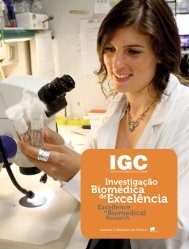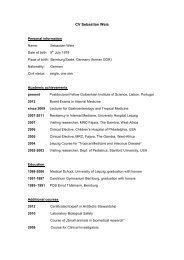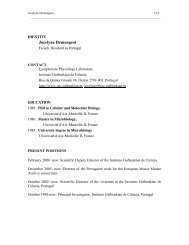organisation - the Instituto Gulbenkian de Ciência
organisation - the Instituto Gulbenkian de Ciência
organisation - the Instituto Gulbenkian de Ciência
- No tags were found...
Create successful ePaper yourself
Turn your PDF publications into a flip-book with our unique Google optimized e-Paper software.
NEURONAL<br />
STRUCTURE<br />
AND FUNCTION<br />
Inbal Israely Research Fellow<br />
PhD in Neuroscience, University of California, Los Angeles, 2004<br />
Post-doctoral Associate, MIT, USA<br />
THIS GROUP IS A MEMBER OF THE CHAMPALIMAUD NEUROSCIENCE PROGRAMME AT THE IGC<br />
Research Fellow at <strong>the</strong> IGC since 2009<br />
link to external website<br />
We are interested in un<strong>de</strong>rstanding how activity can lead to specific structural<br />
changes in neurons which may be important for learning, and how such changes<br />
affect connectivity within neural circuits. It is unknown how <strong>the</strong> diverse forms<br />
of activity that a neuron receives are physically stored and regulated at <strong>the</strong><br />
level of individual spines, <strong>the</strong> sites of neuronal connections. Does long lasting<br />
<strong>de</strong>pression lead to structural changes at synapses? What types of structural<br />
and electrophysiological modifications take place at spines following complex<br />
patterns of naturally occurring activity? Several mental retardation disor<strong>de</strong>rs in<br />
humans are characterised by abnormal spine morphology, and studying neurons<br />
from animal mo<strong>de</strong>ls may fur<strong>the</strong>r our un<strong>de</strong>rstanding of <strong>the</strong> relationship between<br />
structure and function. We aim to combine molecular and genetic tools with<br />
imaging and electrophysiological methodologies, to <strong>de</strong>termine how information<br />
is physically stored in <strong>the</strong> brain.<br />
GROUP MEMBERS<br />
Yazmin Ramiro Cortes (Post-doc)<br />
Anna Hobbiss (PhD Stu<strong>de</strong>nt)<br />
Ali Ozgur Argunsah (PhD Stu<strong>de</strong>nt)<br />
COLLABORATORS<br />
Thomas McHugh (Riken Brain Science Institute, Japan)<br />
Devrim Ünay (Bahcesehir University, Turkey)<br />
FUNDING<br />
Champalimaud Foundation (CF), Portugal<br />
Bial Foundation, Portugal<br />
DENDRITIC COMPARTMENTALISATION OF PROTEIN SYNTHESIS-DEPENDENT<br />
SYNAPTIC PLASTICITY<br />
We found that protein syn<strong>the</strong>sis <strong>de</strong>pen<strong>de</strong>nt stimulation of spines can facilitate<br />
plasticity at neighbouring spines for up to an hour and over long distances (70<br />
micra). Through 2-photon imaging and uncaging of glutamate at individual spines,<br />
we aim to visualise structural changes that occur in response to protein syn<strong>the</strong>sis<br />
<strong>de</strong>pen<strong>de</strong>nt forms of activity. We will examine how activity at multiple spines leads<br />
to structural changes and changes in synaptic weights within a <strong>de</strong>ndritic branch.<br />
We aim to <strong>de</strong>termine whe<strong>the</strong>r competition for proteins during synaptic plasticity<br />
can shape <strong>the</strong> organization of inputs within a <strong>de</strong>ndrite, leading to <strong>the</strong> physical<br />
clustering of synapses. We also investigate whe<strong>the</strong>r <strong>the</strong> clustering of synapses<br />
can be observed following <strong>the</strong> <strong>de</strong>velopment of neural circuits, by examining <strong>the</strong><br />
endogenous distribution of spines within <strong>de</strong>ndrites of <strong>the</strong> hippocampus.<br />
We find that <strong>the</strong> stimulation of multiple spines closely toge<strong>the</strong>r in time can<br />
lead to competition for cellular resources, and that new proteins are required<br />
for this process. These findings <strong>de</strong>monstrate that synaptic plasticity may be<br />
biologically constrained, and provi<strong>de</strong>s a potential mechanism through which<br />
synapses could be spatially clustered. We are examining <strong>the</strong> parameters over<br />
which competition is regulated, in or<strong>de</strong>r to <strong>de</strong>fine <strong>the</strong> learning rules for protein<br />
syn<strong>the</strong>sis <strong>de</strong>pen<strong>de</strong>nt plasticity.<br />
STRUCTURAL CORRELATES OF SYNAPTIC DEPRESSION AT DENDRITIC SPINES<br />
Synaptic potentiation leads to an enlargement of spine head volumes at individual<br />
synapses, however <strong>the</strong> structural correlates of synaptic <strong>de</strong>pression are<br />
poorly un<strong>de</strong>rstood. Long term <strong>de</strong>pression can be initiated through a variety of<br />
receptors, and it is unknown whe<strong>the</strong>r <strong>the</strong> structural correlates of this form of<br />
plasticity apply generally to any <strong>de</strong>crease of synaptic weight, or whe<strong>the</strong>r <strong>the</strong>re<br />
are specific modifications <strong>de</strong>pending on which signalling pathway is activated.<br />
We aim to <strong>de</strong>termine what are <strong>the</strong> structural correlates of synaptic <strong>de</strong>pression<br />
at <strong>de</strong>ndritic spines. In particular, we are interested in exploring long lasting<br />
forms of synaptic <strong>de</strong>pression that <strong>de</strong>pend on new protein syn<strong>the</strong>sis. We will<br />
<strong>de</strong>termine what are <strong>the</strong> parameters which govern <strong>the</strong>se changes following activity<br />
at specific inputs. Additionally, we will probe whe<strong>the</strong>r new proteins serve<br />
to constrain plasticity at multiple spines similarly to <strong>the</strong> case for long term<br />
potentiation.<br />
We have induced long lasting synaptic <strong>de</strong>pression through <strong>the</strong> activation of<br />
metabotropic glutamate receptors (mGluRs) in hippocampal organotypic slice<br />
cultures. We have quantified <strong>the</strong> structural changes which correlate with this<br />
form of plasticity through 2-photon imaging of subsets of spines for up to four<br />
hours. Additionally, we recor<strong>de</strong>d electrophysiological responses from <strong>the</strong>se<br />
cells in or<strong>de</strong>r to monitor <strong>the</strong> changes following synaptic plasticity.<br />
INDUCING ACTIVITY AT SINGLE DENDRITIC SPINES TO STUDY STRUCTURAL DYNAMICS.<br />
Using 2-photon microscopy in living brain slices toge<strong>the</strong>r with photoactivation<br />
of caged glutamate, we can examine how neurons physically store information at<br />
synapses. We can vary <strong>the</strong> type of stimulation <strong>de</strong>livered at a given input to mimic<br />
different forms of activity, and study what are <strong>the</strong> structural and functional correlates.<br />
We also examine how a neuron integrates information arriving at multiple<br />
synapses.<br />
IGC ANNUAL REPORT ‘11<br />
RESEARCH FELLOWS<br />
75






